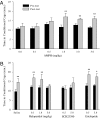Nucleus accumbens dopamine mediates amphetamine-induced impairment of social bonding in a monogamous rodent species
- PMID: 20080553
- PMCID: PMC2824263
- DOI: 10.1073/pnas.0911998107
Nucleus accumbens dopamine mediates amphetamine-induced impairment of social bonding in a monogamous rodent species
Abstract
The prairie vole (Microtus ochrogaster) is a socially monogamous rodent species that forms pair bonds after mating, a behavior in which central dopamine (DA) has been implicated. Here, we used male prairie voles to examine the effects of drug exposure on pair bonding and related neural circuitry. In our first experiment, amphetamine (AMPH) motivated behavior was examined using a conditioned place preference (CPP) paradigm and was shown to be mediated by activation of D1-like DA receptors. Next, we examined the effects of repeated AMPH exposure on pair bonding. Intact and saline pretreated control males displayed mating-induced partner preferences, whereas males pretreated with AMPH at the doses effective to induce CPP failed to show mating-induced partner preferences. Such AMPH treatment also enhanced D1, but not D2, DA receptor expression in the nucleus accumbens (NAcc). Furthermore, pharmacological blockade of D1-like DA receptors in the NAcc rescued mating-induced partner preferences in AMPH-treated males. Together, our data indicate that repeated AMPH exposure may narrow the behavioral repertoire of male prairie voles via a DA receptor-specific mechanism in the NAcc, resulting in the impairment of pair bond formation.
Conflict of interest statement
The authors declare no conflict of interest.
Figures




Similar articles
-
Oxytocin reverses amphetamine-induced deficits in social bonding: evidence for an interaction with nucleus accumbens dopamine.J Neurosci. 2014 Jun 18;34(25):8499-506. doi: 10.1523/JNEUROSCI.4275-13.2014. J Neurosci. 2014. PMID: 24948805 Free PMC article.
-
Social bonding decreases the rewarding properties of amphetamine through a dopamine D1 receptor-mediated mechanism.J Neurosci. 2011 Jun 1;31(22):7960-6. doi: 10.1523/JNEUROSCI.1006-11.2011. J Neurosci. 2011. PMID: 21632917 Free PMC article.
-
Amphetamine alters behavior and mesocorticolimbic dopamine receptor expression in the monogamous female prairie vole.Brain Res. 2011 Jan 7;1367:213-22. doi: 10.1016/j.brainres.2010.09.109. Epub 2010 Oct 8. Brain Res. 2011. PMID: 20933511 Free PMC article.
-
The ties that bond: neurochemistry of attachment in voles.Curr Opin Neurobiol. 2016 Jun;38:80-8. doi: 10.1016/j.conb.2016.04.011. Epub 2016 Apr 30. Curr Opin Neurobiol. 2016. PMID: 27131991 Free PMC article. Review.
-
Neurochemical regulation of pair bonding in male prairie voles.Physiol Behav. 2004 Nov 15;83(2):319-28. doi: 10.1016/j.physbeh.2004.08.024. Physiol Behav. 2004. PMID: 15488548 Review.
Cited by
-
The effects of intranasal oxytocin in opioid-dependent individuals and healthy control subjects: a pilot study.Psychopharmacology (Berl). 2016 Jul;233(13):2571-80. doi: 10.1007/s00213-016-4308-8. Epub 2016 May 3. Psychopharmacology (Berl). 2016. PMID: 27137199 Free PMC article. Clinical Trial.
-
Oxytocin reverses amphetamine-induced deficits in social bonding: evidence for an interaction with nucleus accumbens dopamine.J Neurosci. 2014 Jun 18;34(25):8499-506. doi: 10.1523/JNEUROSCI.4275-13.2014. J Neurosci. 2014. PMID: 24948805 Free PMC article.
-
Social housing and alcohol drinking in male-female pairs of prairie voles (Microtus ochrogaster).Psychopharmacology (Berl). 2012 Nov;224(1):121-32. doi: 10.1007/s00213-012-2836-4. Epub 2012 Aug 18. Psychopharmacology (Berl). 2012. PMID: 22903359 Free PMC article.
-
Genetics of aggression in voles.Adv Genet. 2011;75:121-50. doi: 10.1016/B978-0-12-380858-5.00003-4. Adv Genet. 2011. PMID: 22078479 Free PMC article. Review.
-
Opioid receptors: binding that ties.Neuropsychopharmacology. 2011 Oct;36(11):2157-8. doi: 10.1038/npp.2011.147. Neuropsychopharmacology. 2011. PMID: 21918519 Free PMC article. No abstract available.
References
Publication types
MeSH terms
Substances
Grants and funding
LinkOut - more resources
Full Text Sources

